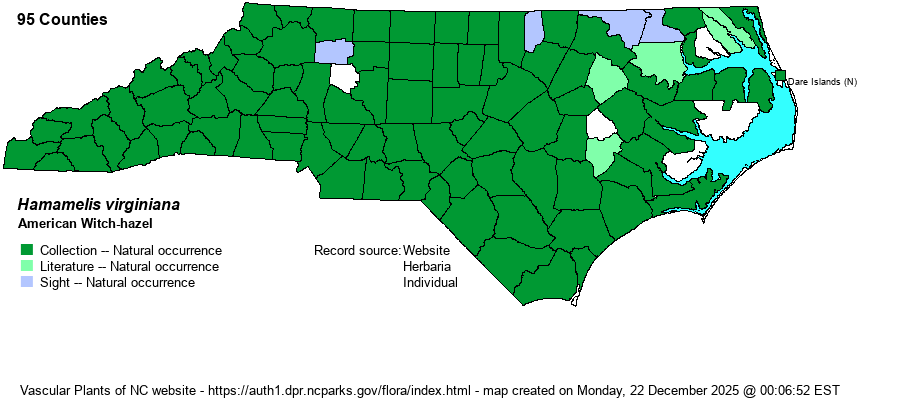| Author | L. | |
| Distribution | Essentially statewide, but as with many other “statewide” woody species, there is a lack or scarcity of records for the far eastern and northeastern counties. Likely present in all 100 counties.
This is a very widespread species of the Eastern U.S. and eastern Canada. It ranges to southern FL and to central TX and is known from the great majority of counties within this large range.
| |
| Abundance | Common and very widespread across nearly all of the state, but rare to uncommon in the northeastern part of the state. | |
| Habitat | This is a familiar species of fairly dry to fairly moist forests, with a wide range of suitable habitats. It occurs in oak-hickory forests, mesic mixed hardwoods, various pine-hardwoods, and floodplain forests. It may also grow in rocky woods. A walk in an upland or bottomland forest will most likely reveal at least a few of these small trees. |
| Phenology | One of the very few plant species in NC that blooms in late fall and early winter – from October into December. Fruits in October and November of the following year. | |
| Identification | This is a small deciduous tree (or a very large shrub) that grows with a single trunk to a height of 15-20 feet tall. It has alternate leaves that are somewhat elliptical but with distinct large wavy serrations on the outer half, growing to 3-4 inches long. The leaf bases are often irregular and not symmetrical. In most of the state, these leaves are suitable for identification, but in some places in the Piedmont and mountains it can be confused with Fothergilla major, which has wider (more rotund) leaves and a completely different flower. Likewise, in the Coastal Plain, F. gardenii can occur with or close to Hamamelis, but the Fothergilla has glaucous blue-green leaves, almost always grows in pocosin/bay wetlands, and has a different flower. In late fall, one can see the bizarre flowers, which contain four stringy yellow petals; they are quite a sight on a tree with the leaves already having been dropped. | |
| Taxonomic Comments | This species has several varieties, though essentially the only one occurring in NC is the nominate one – H. virginiana var. virginiana. However, Weakley (2024) indicates that var. henryae has been collected in Hoke County. See that account for more information.
| |
| Other Common Name(s) | Common Witch-hazel. As there is another eastern species of Hamamelis, a modifier name is usually used and preferred. Of course, within NC it is suitable just to use “Witch-hazel” in a report, in conversation, etc. | |
| State Rank | S5 | |
| Global Rank | G5 | |
| State Status | | |
| US Status | | |
| USACE-agcp | FACU link |
| USACE-emp | FACU link |

